Share
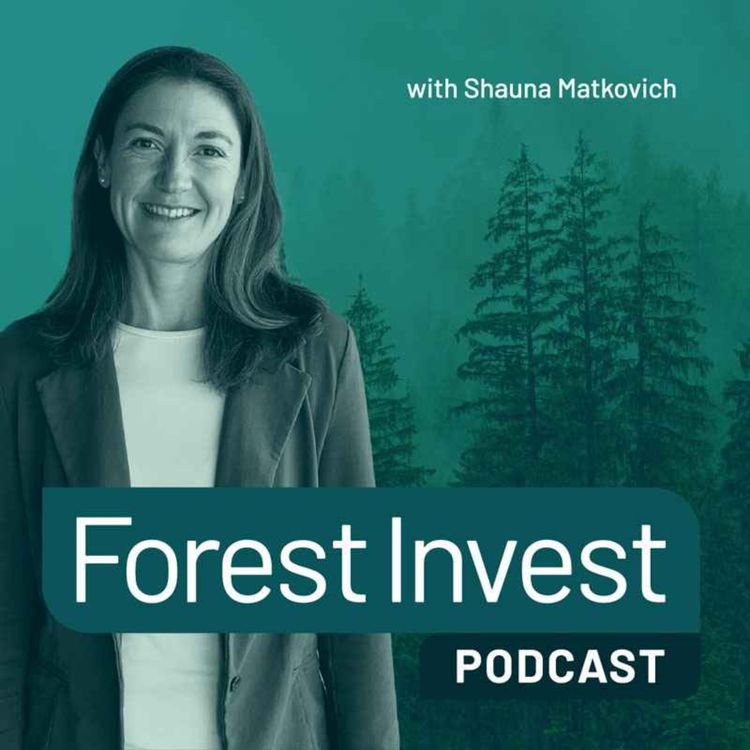
Forest Invest
Five Sustainability Reasons Your Forest Investment Fund isn't Closing with Shauna Matkovich
In this solo episode, I reflect on Posaidon's outlook for nature finance in 2025, highlighting why it's a pivotal moment for forest investment. With rising demand for nature-based climate solutions, global biodiversity concerns, and a shift toward renewable products, forests are uniquely positioned to help asset owners meet fiscal regulatory requirements—while delivering strong returns. Yet, new forest investment strategies are slow to close. Beyond the usual hurdles like track record and pipeline, what about sustainability challenges? I break down five key sustainability reasons your fund isn’t closing — and how to fix them. Plus, I offer a free advisory call for those looking to refine their sustainability approach.
Free advisory call: Click on the link to book a time
Posaidon Capital: Nature Finance Market Outlook 2025
Host and Forestry Investment Expert: Shauna Matkovich - The ForestLink
Producer and Editor: Magdalena Laas - Unscripted Creatives
01:34
Quote – Nature Finance Market Outlook 2025
03:03
Interesting time for forest investment (great opportunities)
03:48
Questions to ask — when investment strategy does not succeed in raising capital
04:19
Sustainability factors holding back forest investment strategy from landing investors
05:13
Reason # 1: weak sustainability ethos
07:04
Possible solutions
08:22
Reason #2: no point of difference in sustainability strategy objectives from peers
09:06
Possible solutions
09:48
Reason #3: SFDR Article 8, 9, or EU Taxonomy alignment
10:27
Overview – SFDR Article 8
10:38
Overview – SFDR Article 9
10:48
EU Taxonomy
11:19
Possible solutions
12:12
Reason #4: weak sustainability track record
13:06
Possible solutions
14:33
Reason #5: wrong investors
15:07
Possible solutions
Nature by MaxKoMusic/Soundcloud
Sopwell Woodlands and Scohaboy Bog SAC, Cloughjordan, Co Tipperary, IRELAND by wild_rumpus/Soundcloud
Ambient Documentary by Sound Guru/Pixabay
Sign up now for the ForestLink’s newsletter, where you’ll receive technical advice, reflections, and best-practice guidance to support you with your forest-linked investment strategy or business straight to your inbox.
More episodes
View all episodes
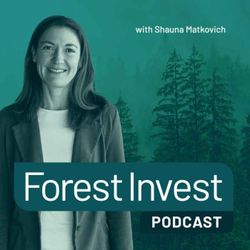
56. Plantation Carbon Forestry in Australia with Andrew Morgan
50:47||Season 2, Ep. 56Andrew Morgan, Managing Director of SFM Agribusiness, a leading forest management operator (timber and carbon projects), joins me to discuss the evolution of Australia’s compliance carbon market. We look at its standards, methodologies, pricing, and the main Australian Carbon Credit Units (ACCU) buyers. Andrew shares insights on SFM’s “ActivAcre” model, which partners landowners with institutional investors, and explores how carbon credits are reshaping forestry portfolios.If you'd asked me 3 or 4 years ago, carbon and a carbon strategy weren't even considered by most institutional investors when looking at larger assets. It's now a really important part of the value. Traditionally, it was the land and the tree crop. There's now land, tree crop, and carbon. And it could be forming 20 - 30% of the total valuation.Useful ResourcesThe ForestLink newsletter signupSFM - Plantation Carbon PartnersProduction TeamFounding Director and Host: Shauna Matkovich - The ForestLinkProducer and Editor: Magdalena Laas - Unscripted CreativesChapters [0:48] Background & SFM Agribusiness [2:25] SFM’s Role in Forest Investment Operations [3:16] Evolution of Carbon Forestry (Australia) [6:31] Understanding Carbon Project Methodologies (Schedules 1–4) [8:02] First Carbon Project & Early Learnings [9:06] The Drivers: Climate & Timber Deficit [10:22] Land Constraints & Strategic Aggregation Models [11:27] How the Australian Carbon Market Works [12:23] Pricing, Credit Types & Market Trends [13:48] Buyers in the Compliance Carbon Market [15:20] Compliance vs. Voluntary Markets [16:22] Strengths & Weaknesses of the Compliance System [17:50] Challenges with Timelines, Audits & Approval Delays [20:03] Investor Confidence & Carbon Modeling [21:05] Market Demand Outlook to 2033 [22:01] Carbon's Emerging Role in Asset Valuation [23:44] The Active Acre Model: Origins & Design [26:33] Retail-Focused Landowner Partnerships [28:56] Land Aggregation Strategy & Regional Development [30:01] Farmer Engagement & Early Adoption Curve [30:52] Landowner Concerns: Tenure, Risk & Trust [32:14] Fire Risk Management & Industry Networks [33:57] Certification, Biodiversity & AU Plus Potential [34:39] Flexible Models for Participatory Land Use [35:26] Investor Perspectives: Risk, Pipeline & Land Use [38:12] Real Estate Pipeline Management & Land Suitability [40:49] Evolving Client Base: Emitters & AU Offtake [42:22] Unlocking Plantation Forestry Potential [44:36] Emerging Trends in Nature-Based Solutions [46:36] Communicating the Value of Forest Management [49:08] Actionable Advice for New Investors Sound LibraryNature by MaxKoMusic/SoundcloudSopwell Woodlands and Scohaboy Bog SAC, Cloughjordan, Co Tipperary, IRELAND by wild_rumpus/SoundcloudAmbient Documentary by Sound Guru (Pixabay)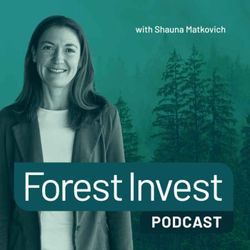
55. Fire is a Fact, but it Can Be Managed – with Tony Pesklevits
41:25||Season 2, Ep. 55Today, I’m joined by Tony Pesklevits, Manager of Wildfire Prevention, Cultural and Prescribed Fire at the BC Wildfire Service. In this conversation, we explore how wildfire management in British Columbia (BC) is evolving to reflect a changing climate, forest ecosystems, communities in the wild-urban interface, and the resurgence of Indigenous fire management. Tony shares how fire has always shaped BC’s forests and how reintroducing “good fire” through cultural and prescribed burning is key to resilience. We cover what makes for an effective forest manager from a wildfire risk lens, the importance of collaboration across sectors, and how investors should think about fire. Not as a risk to fear, but as a force to understand and manage.“Fire has been a part of forest ecosystems for as long as photosynthesis has been a part of forest ecosystems. They are two parts of the same cycle.”"Fire is a fact. It’s not a mystical risk. It can be understood and it can be managed. If you remove fire from those ecosystems, you can actually create risk for the asset."Useful ResourcesThe ForestLink newsletter signupWildfire Service, Province of British ColumbiaCultural Burning & Prescribed FireFireSmart BCTony Pesklevits (LinkedIn)Yellow Birch (Betula alleghaniensis)Production TeamFounding Director and Host: Shauna Matkovich - The ForestLinkProducer and Editor: Magdalena Laas - Unscripted CreativesChapters[00:00] Introduction & Guest Welcome[01:05] Tony’s Favorite Tree & Background[03:18] From Conservation to Wildfire Management[04:44] Overview of Tony’s Current Role[05:20] The Role & Mandate of the BC Wildfire Service[07:17] Cultural vs. Prescribed Fire[10:06] Building Partnerships with First Nations[11:02] Monitoring & Measuring Fire Outcomes[13:36] Adaptive Management in Fire Practices[13:56] Community Perceptions & Communication[16:08] The Williams Lake Burn Case Study[17:34] Forest Management Without Fire[20:11] Forest Practices to Reduce Wildfire Risk[22:16] Collaboration with the Forest Industry[24:16] Fire Surveillance Techniques[27:48] Emerging Technologies in Fire Detection[28:17] Funding & Responsibility for Wildfire Response[29:46] Cross-Border & Interagency Cooperation[32:29] Lessons Learned Since 2017[34:07] FireSmart & Community-Level Actions[35:35] The Role of Forest Managers[37:02] Actionable Advice for Forest Investors[40:06] Where to Learn More[41:09] Outro & Closing RemarksSound LibraryNature by MaxKoMusic/SoundcloudSopwell Woodlands and Scohaboy Bog SAC, Cloughjordan, Co Tipperary, IRELAND by wild_rumpus/SoundcloudAmbient Documentary by Sound Guru (Pixabay)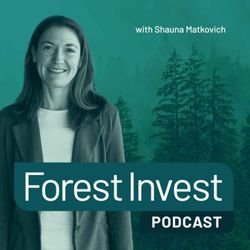
54. Raising the Accessibility of Nature Data – With Alex Logan
44:34||Season 2, Ep. 54Today, Alex Logan, CEO and Co-Founder of Cecil, joins me on the Forest Invest podcast. We explore how Cecil is helping bridge the gap between complex nature data sets and real-world applications by addressing a growing challenge in forest investment: accessible, accurate, and actionable nature data. We discuss the importance of understanding the limitations of current data, the need for better “ground-truthing,” and the complexities of localized ecosystems. Alex also shares what the future might hold as biodiversity reporting standards begin to catch up with climate disclosures – and leaves us with one core insight: there’s no silver bullet, only the power of leaning into complexity with the right team.Quote“The most requested data set we get asked for at the moment are the key-protected areas and red list data sets – driven by regulatory pressure around nature risk.”“There's a big missing piece in the world right now, and that’s reliable, global ground-truth data to benchmark and train nature models.”Useful ResourcesCecilAlex Logan (LinkedIn)The ForestLink newsletter signupProduction TeamFounding Director and Host: Shauna Matkovich - The ForestLinkProducer and Editor: Magdalena Laas - Unscripted CreativesChapters[00:00] Introduction: Meet Alex Logan, CEO of Cecil [00:31] What’s Your Favorite Tree? [01:00] Alex’s Background and Career Journey [01:46] The Birth of Cecil: From Climate to Nature [02:57] Why Nature Data Matters [03:53] The Problem Cecil is Solving [04:35] How Cecil Has Evolved Over Time [06:06] Pivoting to a Data-Centric Model [07:34] What Is Nature Data? [08:56] Who Uses Cecil’s Platform? [10:13] Real-World Use Case: Land Banking Group [11:21] Most Requested Data Sets [12:50] Data Set Reliability & Curation Challenges [15:07] Why Context Matters in Data Application [16:41] The Vision: Smart Data Set Recommendations [17:33] Questions to Ask Your Nature Data Provider [19:11] Cost vs. Resolution in Remote Sensing [20:55] Temporal Coverage and Use Cases [21:28] What Users Want Most: Accuracy & Trust [23:27] How to Improve Model Accuracy [24:19] The Ground Truth Challenge [26:02] Reducing Costs & Funding Nature Data [28:39] Advice for Small Forest Landowners [31:25] Creating an Economy Around Nature Data [33:01] Making Complex Data Accessible [34:28] The Role of Intermediaries like Land Banking Group [36:41] Standard Setting in Nature Disclosures [39:20] Crystal Ball: The Next 12 Months in Nature Data [41:23] Final Reflections & Where to Learn More Sound LibraryNature by MaxKoMusic/SoundcloudSopwell Woodlands and Scohaboy Bog SAC, Cloughjordan, Co Tipperary, IRELAND by wild_rumpus/SoundcloudAmbient Documentary by Sound Guru (Pixabay)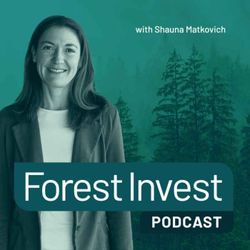
53. An Industrial Perspective on Forest Investment in Africa – with Hans Lemm
39:16||Season 2, Ep. 53Today, I’m joined by Hans Lemm, Director of Acacia Africa Advisors and former CEO of East Africa’s largest forest company. In this conversation, Hans shares lessons from over two decades of leading industrial forestry businesses across the emerging markets of Tanzania, Uganda, Kenya, Mozambique, and South Sudan. We explore what’s changed and what hasn’t in African forestry, from the growing role of smallholder farmers to the influx of Asian processing investment. Hans offers practical insights on managing operational and reputational risks, outlines investor misconceptions, and explains why inclusive value chains and realistic projections are key to successful forest investment. We also talk about the critical (but often misunderstood) role of carbon finance and the job-creation potential of forest industrialization.QuoteAfrica is generally a good place to grow trees. Trees grow fast here, and there are appealing fundamentals like a growing middle class and urbanization—but it remains a complex operating environment.Despite assumptions, I’ve never seen real problems around political risk or land tenure in my 20+ years of experience across the region. The risks are different than people often think.Useful ResourcesThe ForestLink newsletter signupHans Lemm on LinkedInProduction TeamFounding Director and Host: Shauna Matkovich - The ForestLinkProducer and Editor: Magdalena Laas - Unscripted CreativesChapters00:00] Introduction – Meet your host, Shauna Matkovich[00:19] Guest intro – Hans Lemm of Acacia Africa Advisors[01:12] Hans’s journey: 25 years in African forestry[03:08] How Africa’s forest sector has changed – and what hasn’t[04:12] More than just planting: The need for downstream investment[05:14] The role of smallholder tree farmers[06:27] What happens when industrial capacity lags behind wood supply?[07:16] Rise of Asian investors and local processing[08:27] Domestic markets: Still largely informal[09:37] What still needs to change: Standards, logistics & regulation[11:11] Ingredients for a sustainable forestry business[13:01] Real vs. perceived investment risks[15:06] Taxation and technical missteps – hidden threats[17:06] Local knowledge matters – even within small regions[18:02] Forex, investor fatigue & reputational concerns[19:09] Aligning operators and investors for long-term success[21:52] Reporting pressure in emerging markets[24:08] The role of DFIs in African forestry[26:32] Key market drivers: Trade with Asia, local manufacturing[28:14] Carbon finance: Tool or trap?[30:07] Forestry as a job engine and community license to operate[33:01] Field story: The cobra in Uganda[33:19] Mentorship and career-defining moments[34:54] Evacuation in South Sudan – and the best beer ever[37:04] What’s next for Hans Lemm[38:00] Final advice to investors: Be realistic[38:41] Where to find Hans Lemm online[39:00] Outro – Thanks from Shauna MatkovichSound LibraryNature by MaxKoMusic/SoundcloudSopwell Woodlands and Scohaboy Bog SAC, Cloughjordan, Co Tipperary, IRELAND by wild_rumpus/SoundcloudAmbient Documentary by Sound Guru (Pixabay)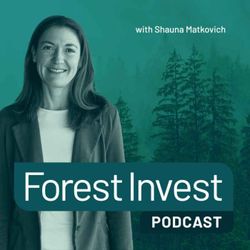
52. Securitization in Emerging Market Forest Investment with Alessandro Materni
47:39||Season 2, Ep. 52Alessandro Materni, Managing Partner at FLS Forestry Linked Securities, joins me on The Forest Investment Podcast. Today, we explore how securitization can revolutionize forest investment in the Global South, making it more accessible to institutional investors. Alessandro breaks down the mechanics of forestry-backed securities, the unique advantages of reforestation in Paraguay, and the safeguards needed to mitigate ESG and political risks. We also discuss FLS's mission-driven strategy, seeking long-term investor returns with biodiversity, climate, and social impact goals. If you're interested in learning alternative approaches to structuring finance in a forest investment, this episode offers great lessons.QuoteWe try to shield assets from political risk and local idiosyncrasies as much as possible, to make them securitizable, and ultimately investable.Useful ResourcesThe ForestLink newsletter signupAlessandro Matterni LinkedInFLS Forestry Linked SecuritiesFLS on LinkedInStrawberry tree (Arbutus unedo) & Lapacho (Handroanthus impetiginosus)Production TeamFounding Director and Host: Shauna Matkovich - The ForestLinkProducer and Editor: Magdalena Laas - Unscripted CreativesChapters[00:00] Introduction to Forest Invest with Shauna Matkovich[00:21] Meet the Guest: Alessandro Materni of FLS[00:35] Alessandro’s Favorite Trees: Strawberry Tree & Lapacho[02:05] Introduction to Alessandro and FLS Forestry Linked Securities[04:45] Explaining Securitization in Forestry Terms[07:18] Rating Agencies & Forestry Assets[08:46] Scale of Institutional Forestry Investment[10:06] How FLS Aims to Expand Forestry Markets[12:15] Addressing Political Risk in Emerging Markets[13:49] Why Paraguay? Land, Governance, and Risk Mitigation[17:03] Target Wood Markets in Paraguay[18:35] ESG, Carbon Credits, and Conservation Commitments[21:20] Local Community Engagement and Biodiversity Practices[23:39] Reforestation vs. Mature Asset Strategy[24:39] Life Cycle of Forest Investment and Securitization Timing[27:02] Exit Options and Evergreen Structure[29:39] Investor Profiles and Suitability[32:12] Is This Strategy Right for Forestry Newcomers?[34:12] Non-Negotiable ESG Commitments[36:26] Why Securitization Is Less Common in Developed Markets[38:03] Other Potential Jurisdictions Beyond Paraguay[41:05] Carbon Markets and the Bigger Picture[45:12] Final Advice for New Forest Investors[46:17] Where to Learn More About FLS[47:23] Closing Remarks from ShaunaSound LibraryNature by MaxKoMusic/SoundcloudSopwell Woodlands and Scohaboy Bog SAC, Cloughjordan, Co Tipperary, IRELAND by wild_rumpus/SoundcloudAmbient Documentary by Sound Guru (Pixabay)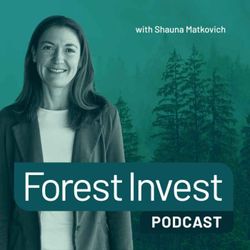
51. Characteristics of an Institutional Forest Investment Portfolio for Financial and Climate Objectives – with Olly Hughes and David Gardner
44:05||Season 2, Ep. 51Today, I’m joined by Olly Hughes, Managing Director of Forestry, and David Gardner, Chief Investment Officer for Forestry at Gresham House. In this discussion, we explore how Gresham House builds global forestry portfolios that incorporate both financial and climate-related considerations. Olly explains why timberland offers stable, inflation-linked returns and outlines how it fits into the “natural capital” asset class, where sustainable timber, carbon credits, and biodiversity gains converge. David adds rich insight into long-rotation conifer crops and how afforestation and compliance carbon markets (especially in Australia and New Zealand) can support early cash flow. We delve into the significance of establishing KPIs for biodiversity and why experiencing a forest firsthand can be the most effective education for new investors.Quote“We believe global timber demand will nearly triple over the next 30 years, so we must plant trees both for nature-based reasons and for timber supply.” – Olly Hughes “Certification is just the starting point—we manage to global standards and then layer on sustainability objectives to meet Article 9 criteria.” – David GardnerUseful ResourcesGresham HouseOlly Hughes (LinkedIn)David Gardner (LinkedIn)The ForestLink newsletter signupFavorite trees: Walnut (Juglans regia) & Ginkgo BilobaProduction TeamFounding Director and Host: Shauna Matkovich - The ForestLinkProducer and Editor: Magdalena Laas - Unscripted CreativesChapters[00:00] Intro & Welcome[00:35] Favorite Trees[01:19] Introductions & Gresham House Overview[04:19] Why Forestry? Key Investment Benefits[08:52] Case Study: Forestry Resilience During Recession[10:47] Climate Goals & Misconceptions[15:37] Policy Regulations & Market Impact[18:08] Best Geographies Where Climate and Returns Align[22:33] Portfolio Strategy – Mixing New and Mature Assets.[24:10] Carbon Markets 101[27:02] Timber vs. Carbon Returns[29:01] Nature & Biodiversity Investing[36:59] Managing Forests & Funds, Sustainability Meets Scalability.[39:02] Global Standards for Nature and Carbon[39:26] Inspiration & Frustration[42:00] Final Advice[43:13] Closing & Contact InfoSound LibraryNature by MaxKoMusic/SoundcloudSopwell Woodlands and Scohaboy Bog SAC, Cloughjordan, Co Tipperary, IRELAND by wild_rumpus/SoundcloudAmbient Documentary by Sound Guru (Pixabay)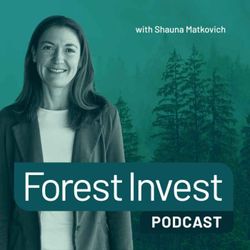
50. Collaborating for Forest Production and Restoration at Scale – with Charlotte Kaiser and Esben Brandi
42:23||Season 2, Ep. 50Today, I’m joined by Charlotte Kaiser, Head of Impact Finance, and Esben Brandi, Head of Business Development at BTG Pactual Timberland Investment Group (TIG). In this episode, we explore how TIG is collaborating with Conservation International and The Nature Conservancy to achieve ambitious climate and biodiversity outcomes. We discuss the operational integration of production forestry and restoration components in Latin America, boosting forest resilience through tweaks in management across U.S.-based assets, and how trusted environmental collaborators help address reputational concerns while building investor confidence. Charlotte and Esben share insights into evolving investor expectations, the role of science-based planning, and how these structured NGO engagements support both performance and purpose across forest landscapes.Quotes"Each institution needs to make the other partner’s goals and challenges their own so that we can become a single team working toward a shared set of outcomes.” - Charlotte“It’s a very healthy and worthwhile process to sit in the same room and work through different objectives to maximize both impact and financial success.” - EsbenUseful ResourcesBTG Pactual Timberland Investment GroupCharlotte Kaiser (LinkedIn)Esben Brandi (LinkedIn)BTG Pactual Timberland Investment GroupThe ForestLink newsletter signupProduction TeamFounding Director and Host: Shauna Matkovich - The ForestLinkProducer and Editor: Magdalena Laas - Unscripted Creatives[00:14] Welcome and introduction to the guests[00:39] Favorite trees of Charlotte and Esben[01:56] Quick bios and roles at TIG[03:45] Introduction to TIG and its client base[05:35] Notable corporate collaborations, including Apple[06:58] Why TIG collaborates with environmental NGOs[08:10] Roles of The Nature Conservancy and Conservation International[10:18] Investor sentiment and current demand[11:42] Differences in engagement models: North America vs Latin America[13:36] Asset-level monitoring and biodiversity interventions[17:14] Land sparing strategy and integration of restoration[18:08] Specific impact targets for restoration and carbon[19:32] Governance structures with NGO partners[22:15] Balancing NGO goals with investor needs[26:46] Navigating trade-offs and alignment of objectives[30:10] External stakeholder feedback and carbon buyers' interests[33:33] Key results: carbon deals, restoration milestones, endangered species sightings[36:23] Restoration R&D in the Cerrado biome[37:58] Key lessons from cross-sector collaboration[38:35] What’s next for TIG[40:36] Actionable advice for new forest investors[42:10] Where to learn more about TIG’s workSound LibraryNature by MaxKoMusic/SoundcloudSopwell Woodlands and Scohaboy Bog SAC, Cloughjordan, Co Tipperary, IRELAND by wild_rumpus/SoundcloudAmbient Documentary by Sound Guru (Pixabay)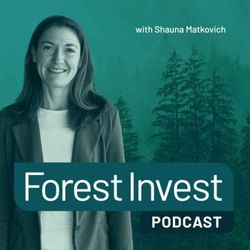
49. Corporate Forest Investment via the Future Forest Innovations Fund – with Geoffrey Seeto
48:24||Season 2, Ep. 49In this episode, I’m joined by Geoffrey Seeto, Senior Managing Director and Head of Emerging Markets at New Forests, to discuss the Future Forest Innovations Fund — a global, open-ended forestry vehicle co-developed with Oji Holdings. Geoffrey explains how the Fund aims to meet climate targets through a high-integrity insetting strategy and achieve full FSC certification across its portfolio. We explore how the open-ended structure supports long-term forest stewardship and enables net carbon sequestration under the GHG Protocol and steady timber returns. Geoffrey also shares how corporate capital is driving forest expansion in emerging markets and reshaping the future of forest finance.Quote"An open-ended structure allows us to steward forests into perpetuity, which is critical for both carbon permanence and long-term timber value creation."Useful ResourcesThe ForestLink newsletter signupGeoffrey Seeto on LinkedInNews: New Forests partners with Oji Holdings to establish a forestry fund to help meet 2030 goalsFavorite tree: EucalyptusProduction TeamFounding Director and Host: Shauna Matkovich - The ForestLinkProducer and Editor: Magdalena Laas - Unscripted CreativesChapters[00:00] Welcome & Guest Introduction[00:35] Geoffrey's Favorite Tree[01:25] Geoffrey’s Role at New Forests[02:15] Emerging Markets vs. Developed Markets[03:55] Positive Impact & Mixed Landscape Approach[05:12] Introduction to the Future Forest Innovation Fund (FFI)[05:34] Origins of the OG Partnership[06:58] High Sustainability Standards & FSC Certification[07:53] OG's 2030 Climate Goals & Role of New Forests[08:51] Vertical Integration & Local Economic Impact[10:13] Defining “Innovation” in FFI[11:18] Permanent Capital Vehicle Explained[12:56] The Case for Investing in Emerging Markets[13:25] Why Open-Ended Funds Work for Forestry[15:34] Institutional Appeal & Long-Term Stewardship[17:23] African Fund & Perpetual Management[18:44] Building a Global Forestry Portfolio[22:01] Regional Allocation Breakdown[23:38] Why Latin America is Next[25:00] Asset Characteristics: Species, Maturity & Market Access[28:03] Certification: FSC, Carbon Standards, and SFDR[30:20] Carbon Insetting vs. Offsetting[32:28] OG’s Role & Future Investors[35:30] Corporate vs. Institutional Investors[38:35] Voluntary Carbon Markets & Paris Targets[40:25] Meeting Different Investor Needs[41:36] Lessons from Infrastructure & Forestry Growth[43:42] Final Advice for New Investors[47:25] Where to Learn More[48:00] Closing RemarksSound LibraryNature by MaxKoMusic/SoundcloudSopwell Woodlands and Scohaboy Bog SAC, Cloughjordan, Co Tipperary, IRELAND by wild_rumpus/SoundcloudAmbient Documentary by Sound Guru (Pixabay)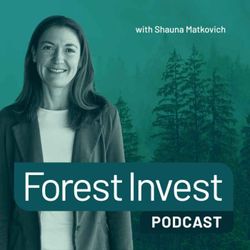
48. Forest Investment via Continuous Cover Forestry (CCF) – with Darius Sarshar
45:44||Season 2, Ep. 48Today, I am joined by Darius Sarshar, Principal at SLM Partners. In this episode, Darius makes a compelling case for Continuous Cover Forestry (CCF) as a regenerative, climate-resilient alternative to clear-fell forest management models. We explore when CCF makes sense and how it delivers both strong financial returns and meaningful ecological benefits, boosting IRRs, enhancing biodiversity, and generating carbon credits. By maintaining a permanent forest canopy, CCF enhances resilience to storms, drought, and pests, while fostering natural regeneration. From a financial perspective, it evens out and brings forward timber revenues, generating earlier, steadier cash flows. This episode is essential for investors seeking a smart, nature-aligned approach to timberland.Quote"Continuous cover forestry is about managing complexity—with biodiversity, resilience, and timber income all improving over time. It’s not just sustainable—it’s sensible."Useful ResourcesThe ForestLink newsletter signupSLM PartnersWhite Paper: Investing in Continuous Cover Forestry (CCF) in EuropeDarius Sarshar on LinkedInFavorite tree: Sitka Spruce (Picea sitchensis)Production TeamFounding Director and Host: Shauna Matkovich - The ForestLinkProducer and Editor: Magdalena Laas - Unscripted CreativesChapters[00:00] Welcome & Introduction[00:31] Darius’ Favorite Tree: Sitka Spruce[01:44] Darius’ Career Journey & About SLM Partners[04:11] Emerging vs. Core Markets: Lessons from the Tropics[05:24] Why Europe Is Underrepresented in Forest Investment[08:12] Challenges & Opportunities in European Forestry[11:08] Intro to Continuous Cover Forestry (CCF)[13:39] Where is CCF Applicable? Site & Species Suitability[16:04] Policy, Regulation & Societal Drivers for CCF[18:01] Why SLM Adopted CCF: Research & Evidence[19:52] Financial Performance: CCF vs. Clearfell[23:54] Monocultures to Mixed Forests: The Transition Strategy[25:40] Carbon Benefits & Carbon Credit Eligibility[28:55] Timber + Carbon Strategy: Is the Regime Different?[30:42] Active Management Benefits: Timber, Carbon & Biodiversity[33:14] Social Impact of CCF: Jobs, Communities, and Recreation[35:44] Addressing Concerns: Disturbance & Soil Compaction[39:07] Investor Education: Risk, Data & Demand for Authenticity[42:14] Final Reflections & The Growing CCF Movement[44:33] Darius’ Actionable Advice to New Forest Investors[45:28] Closing & Next Episode TeaserSound LibraryNature by MaxKoMusic/SoundcloudSopwell Woodlands and Scohaboy Bog SAC, Cloughjordan, Co Tipperary, IRELAND by wild_rumpus/SoundcloudAmbient Documentary by Sound Guru (Pixabay)